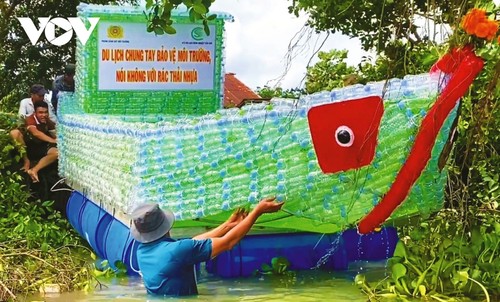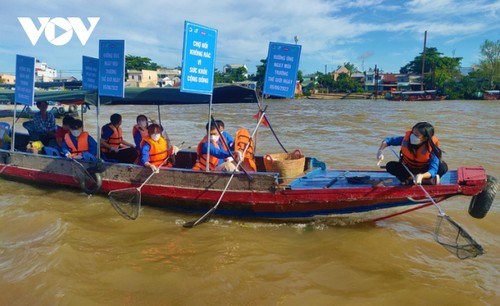 The boat made from hundreds of plastic bottles at Con Son. The boat made from hundreds of plastic bottles at Con Son.
|
Visitors to Con Son community tourism village in Binh Thuy district are impressed with a boat made from hundreds of plastic bottles docked at the wharf.
The special boat was launched a year ago to raise awareness of environmental protection and call on all people to keep Con Son clean and beautiful. As a result, the village has become a popular destination on the Mekong River tour.
Tran Van Tien of Hai Phong city recalled, “Visiting Con Son, what surprises me most is the clean environment. I hope local tour operators will continue to uphold the model so that tourists can live with nature.”
Con Son’s tourism has been prospering thanks to the government's cooperation with GreenHub and the Research Centre for Resources and Rural Development (RECERD) to implement the zero waste to Mekong River project.
Funded by the Dow Chemical Vietnam Company (Dow Vietnam), the project aims to pilot a circular economy model for floating markets and tourism islets along the Mekong River.
Launched last May, the project has supported models to classify waste at source, waste treatment using a circular economy model, and training courses to improve public awareness.
GreenHub has provided 140 two-compartment waste bins and waste sorting devices for the households living permanently on the river and Con Son islet.
GreenHub has also helped residents deploy a model to separate waste on the river with nets and equip a specialized ship to transport garbage from the islet to inland garbage collection places.
Between last September and May of this year, more than 300 tons of waste from Cai Rang floating market and 30 tons from the Con Son community have been collected and treated.
Le Thi Be Bay, who offers tourism services on Con Son, said that since they began engaging in tourism, people have improved their awareness of environmental protection.
Bay added that waste sorting and recycling, and collection of trash floating on the river have made a good impression on visitors to Con Son.
“Unless there are too many tourists, every 3 days all of us clean up the waste around our house. Every day, teams collect plastic waste and disposable plastic bottles left by tourists to keep the environment clean,” said Bay.
 Collecting waste on the Hau River has become a routine since the project began in 2022. Collecting waste on the Hau River has become a routine since the project began in 2022. |
At a recent conference to review the project’s outcomes, Tran Thi Hoa, GreenHub’s Director, said the project’s achievements have been due to active participation by the Can Tho government and people.
330 tons of waste were collected on the Mekong River in the past year, creating a foundation, connecting the community, and mobilizing resources to practice a green lifestyle, green production, and nature conservation.
This has contributed to developing Can Tho’s river-tourism, said Hoa.
“Cai Rang floating market and Con Son islet were chosen because they are tourist attractions and have a large volume of waste”, Hoa recalled, adding, “The project is building a pilot model of garbage collecting and sorting, which the locality will continue after the project ends.”
Can Tho has also seen other effective waste collection projects on the Mekong River conducted with the Netherlands and the US. This has raised awareness of environmental protection, and tourism attractions in Can Tho have become more “green - clean - safe”.